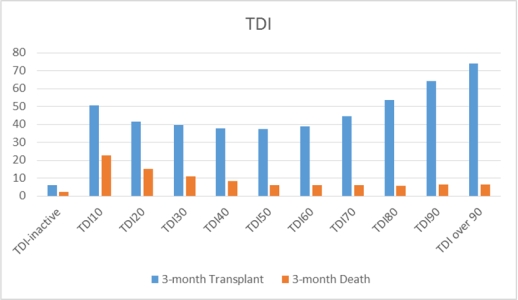The Transplant-Death Index: A Novel Method to Identify Disenfranchised Liver Transplant Waitlist Candidates
Surgery, Division of Abdominal Transplantation, Baylor College of Medicine, Houston, TX.
Meeting: 2018 American Transplant Congress
Abstract number: 74
Keywords: Allocation, Liver transplantation, Survival, Waiting lists
Session Information
Session Name: Concurrent Session: Liver: Recipient Selection
Session Type: Concurrent Session
Date: Sunday, June 3, 2018
Session Time: 2:30pm-4:00pm
 Presentation Time: 3:42pm-3:54pm
Presentation Time: 3:42pm-3:54pm
Location: Room 6C
The transplant field is seeing a shift in outcome priorities from just 1-year survival to include waitlist metrics such as the transplant rate. Identifying disenfranchised patients and considering appropriate risk organs can help maximize the number of patients transplanted and minimize the number of discarded allografts. Given the competing outcomes of waitlisted patients (continued waiting, death, and transplantation), we aimed to identify factors predicting the likelihood a listed candidate would undergo either transplant or death by performing multivariate competing risk analyses of 121,198 candidates listed in the United Network for Organ Sharing database. We incorporated the factors into an index to identify disenfranchised waitlist candidates, the transplant-death index (TDI). Significant predictors of 90-day waitlist activity (either liver transplantation or death) for listed candidates included: age, lab MELD score at listing, blood type, BMI, diabetes mellitus, re-transplantation, hemodialysis, low albumin levels, life support, hepatitis C status, spontaneous bacterial peritonitis, and hospital admission. Approximately half of the patients on the waitlist had low probabilities of both death and transplantation within 90 days (TDI-inactive). The remaining 50% of patients were stratified into 10 groups within a predictive index, the TDI. As the TDI increases, the likelihood of transplantation increases and the likelihood of death decreases. The low-TDI groups (TDI 10, 20) represent candidates with low probabilities of transplantation and high probabilities of death within 90 days. It is this disenfranchised subgroup that would benefit most from considering a marginal allograft. 
CITATION INFORMATION: Kueht M., Goss J., Galvan N., Rana A. The Transplant-Death Index: A Novel Method to Identify Disenfranchised Liver Transplant Waitlist Candidates Am J Transplant. 2017;17 (suppl 3).
To cite this abstract in AMA style:
Kueht M, Goss J, Galvan N, Rana A. The Transplant-Death Index: A Novel Method to Identify Disenfranchised Liver Transplant Waitlist Candidates [abstract]. https://atcmeetingabstracts.com/abstract/the-transplant-death-index-a-novel-method-to-identify-disenfranchised-liver-transplant-waitlist-candidates/. Accessed December 20, 2025.« Back to 2018 American Transplant Congress
